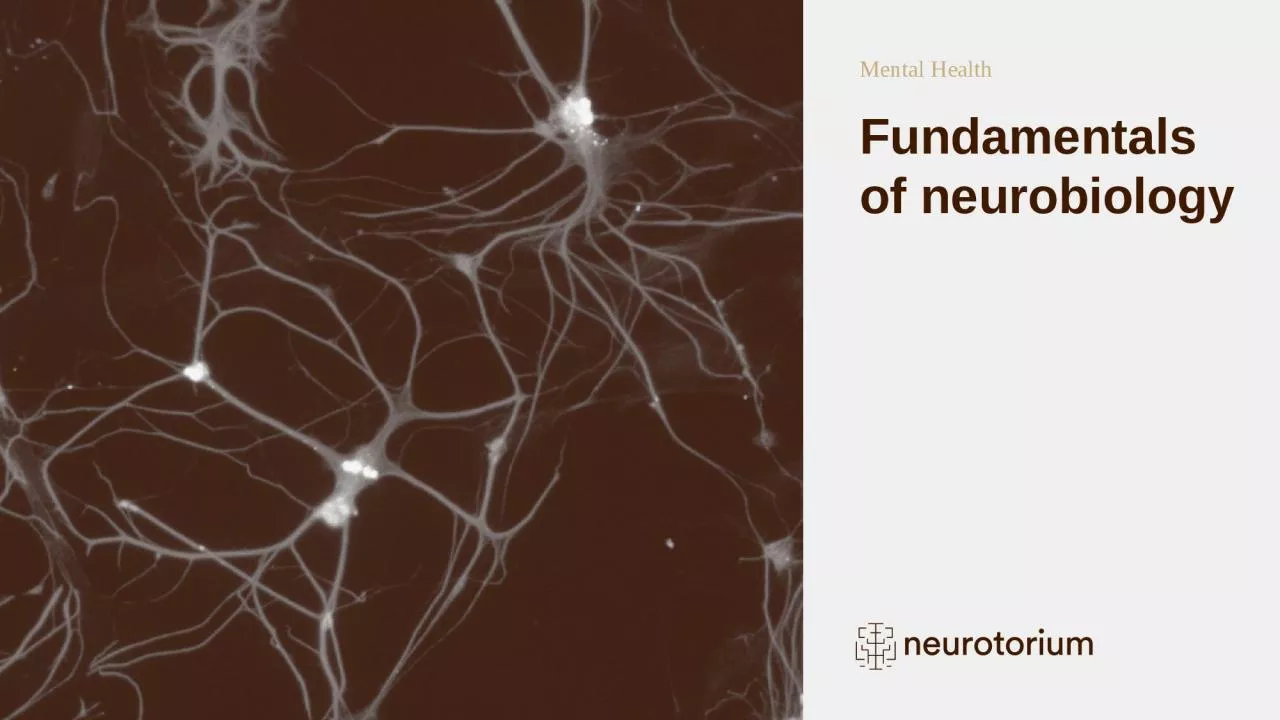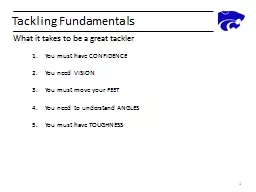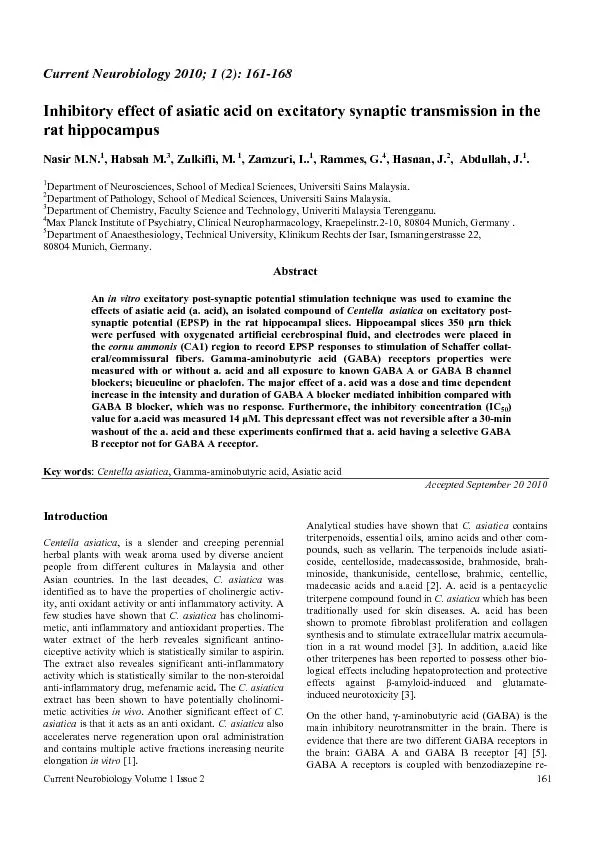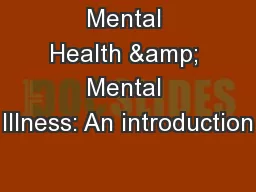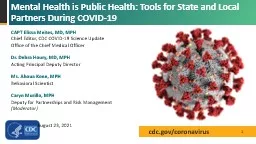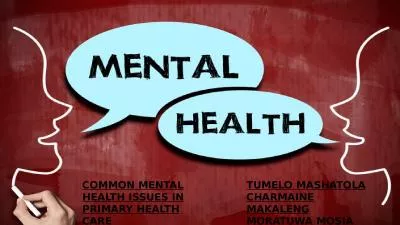PPT-Mental Health Fundamentals of neurobiology
Author : sadie | Published Date : 2024-02-02
Introduction to neurobiology Mental Health 2 Mental Health To understand psychiatric disorders it is important to understand the normal structure and function of
Presentation Embed Code
Download Presentation
Download Presentation The PPT/PDF document "Mental Health Fundamentals of neurobiolo..." is the property of its rightful owner. Permission is granted to download and print the materials on this website for personal, non-commercial use only, and to display it on your personal computer provided you do not modify the materials and that you retain all copyright notices contained in the materials. By downloading content from our website, you accept the terms of this agreement.
Mental Health Fundamentals of neurobiology: Transcript
Introduction to neurobiology Mental Health 2 Mental Health To understand psychiatric disorders it is important to understand the normal structure and function of the nervous system The central nervous system CNS brain spinal cord and peripheral nervous system PNS are composed of two main types of neural cells. ContentslistsavailableatScienceDirectRespiratoryPhysiology&Neurobiology journalhomepage: Earlyabnormalitiesofpost-sighbreathinginamousemodelofRettsyndromeN.Voituron,S.Zanella,C.Menuet,A.M.Lajard,M.Dut What it takes to be a great tackler. 1. You must have CONFIDENCE. You need VISION. You must move your FEET. You need to understand ANGLES. You must have TOUGHNESS. Tackling Fundamentals. Most common mistakes. Current Neurobiology 2010; 1 (2): 161-168 Inhibitory effect of asiatic acid on excitatory synaptic transmission in the Nasir M.N. 1 , Habsah M. 3 , Zulkifli, M. 1 , Zamzuri, I.. 1 4 , Hasnan, J. 2 of a . Thriving Marriage. Selected Scriptures. ©. . November . 8, . 2015. Wade Harlan. ALL MARRIAGES TAKE WORK. Because there are usually big adjustments that must be . made . . .. as we discover more about our spouses.. Elijah M . Marangu. Mental illness.. Or is it madness?. Mental illness.. Or is it madness?. Historical context. While . Philippe . Pinel. , a French Physician was . instrumental in . unchaining . people with mental illness, . Complementary . and . Alternative Medicine (CAM). Health Practices. 1.06 Understand the fundamentals of wellness. Complementary Health Practices. Combines alternative health practices and conventional medical practices. GM VCSE Mental Health Forum (including dementia, perinatal, children, young people and adult mental health) Thursday 14 th February 2019 #VCSEEngage Welcome and Housekeeping Stewart Lucas, Strategic Lead, Mind in Greater Manchester Justin Kerr, RN, MS, PMHNP-BC. “Mental . health is defined as a state of well-being in which every individual realizes his or her own potential, can cope with the normal stresses of life, can work productively and fruitfully, and is able to make a contribution to her or his . . 1. . CAPT Elissa Meites, MD, MPH. Chief Editor, CDC COVID-19 Science Update. Office of the Chief Medical Officer. Dr. Debra Houry, MD, MPH. Acting Principal Deputy Director. Ms. Ahoua Kone, MPH. Chapter . 20. : . Understanding Health and Mental Health Factors Impacting the LGBTQ Community. Authors: . sarah. r. young, . phd. , . msw. Marcie . fisher-borne. , . phd. , . msw. , mph. 1. Chapter 20: Understanding health and mental health factors impacting the . TUMELO MASHATOLA. CHARMAINE MAKALENG. MORATUWA MOSIA. HOW COMMON ARE MENTAL HEALTH ISSUES IN OUR COMMUNITIES?. HOW EDUCATED ARE WE AS PRIMARY/COMMUNITY HEALTH CARE PROFFESSIONALS ABOUT MENTAL HEALTH?. Get complete detail on IT Audit Fundamentals exam guide to crack ISACA IT Audit Fundamentals. You can collect all information on IT Audit Fundamentals tutorial, practice test, books, study material, exam questions, and syllabus. Firm your knowledge on ISACA IT Audit Fundamentals and get ready to crack IT Audit Fundamentals certification. Explore all information on IT Audit Fundamentals exam with number of questions, passing percentage and time duration to complete test. Get complete detail on Cybersecurity Fundamentals exam guide to crack ISACA Certified Cybersecurity Fundamentals. You can collect all information on Cybersecurity Fundamentals tutorial, practice test, books, study material, exam questions, and syllabus. Firm your knowledge on ISACA Certified Cybersecurity Fundamentals and get ready to crack Cybersecurity Fundamentals certification. Explore all information on Cybersecurity Fundamentals exam with number of questions, passing percentage and time duration to complete test. Get complete detail on Data Science Fundamentals exam guide. You can collect all information on ISACA Data Science Fundamentals tutorial, practice test, books, study material, exam questions, and syllabus. Firm your knowledge on Data Science Fundamentals and get ready to crack ISACA Data Science Fundamentals certification. Explore all information on Data Science Fundamentals exam with number of questions, passing percentage and time duration to complete test.
Download Document
Here is the link to download the presentation.
"Mental Health Fundamentals of neurobiology"The content belongs to its owner. You may download and print it for personal use, without modification, and keep all copyright notices. By downloading, you agree to these terms.
Related Documents

